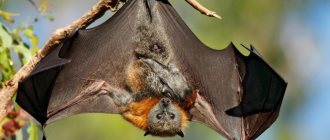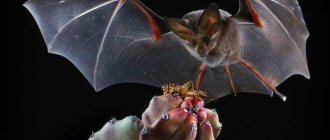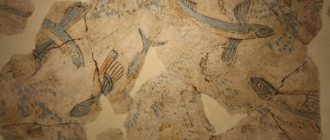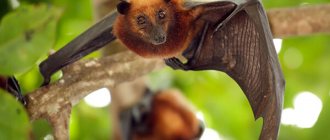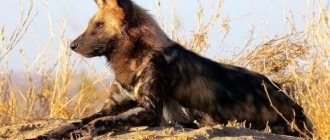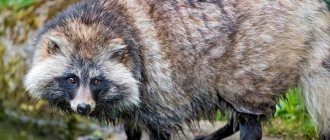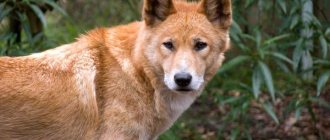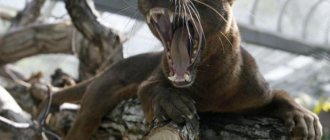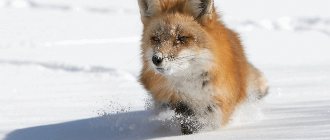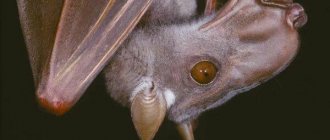This is an animal that belongs to the order Chiroptera. This order has several suborders: bats, fruit bats. Flying dogs or Nile fruit bats are among the latter. They are capable of echolocation, which helps them find food even in pitch darkness. They usually feed on fruits and insects.
At the moment, the species is practically not threatened and is found quite often in nature. But just recently, animals suffered from the fact that cities are growing faster, and therefore there is no place for them to sleep during the day.
Features and habitat of the flying dog
Looking at the photo of a bat dog, one can assume that it is a type of bat. But despite the striking similarity, this is not the case. Like bats, fruit bats can fly almost silently, and in the daytime they prefer to hang upside down on the roof of a house or tree, wrapping their bodies in wide membranes.
If the air temperature is too high, the fruit bat may fan itself with its membranes. During the night, flying dogs can travel about one hundred kilometers. However, the main difference between the fruit bat and bats is that it does not have a special radar that allows it to hunt at night and perfectly navigate the terrain.
Only foxes, whose habitat is caves, have a semblance of an echo sounder; when flying, they click their tongues. Bats are able to produce ultrasonic signals thanks to vocal cords that have a specific structure.
Other types of flying dogs navigate the terrain solely using their senses of sight, smell and touch. In addition, outwardly, fruit bats still look more like dogs or foxes. The flying dog is a mammal of the order Chiroptera, family of fruit bats.
The Egyptian flying dog is widespread in Egypt, the Arabian Peninsula, Turkey and the island of Cyprus. Flying dogs live in India. There are also many fruit bats on the island of Mauritius, in West Africa, in the Philippines, and on the islands of Oceania.
The largest breed of flying dog , called Kalong (its body length is approximately 40 cm, and its forearm is 22 cm). The meat of this flying dog is considered very nutritious.
Local residents catch them and sell them in markets. Kalongs can cause significant damage to fruit plantations. also lives in the Nile Valley, Syria, Iran and Japan. The pygmy fruit bat is the smallest flying dog, its body is only 6-7 cm long and its forearms are 25 cm. It is harmless and lives in Indochina and Burma.
This is interesting: TOP 10 most bloodthirsty sharks
Lifestyle
Animals live in large colonies and are active at night. This species is unique in that, unlike other fruit bats, it has echolocation. During the daytime, caves serve as shelter for flying dogs, where sunlight does not penetrate and where complete darkness reigns. To navigate in such conditions, flying dogs require echolocation. It is possible that some echolocation abilities are also developed in other species of flying dogs, but for now we can confidently speak about the presence of echolocation only in this species. However, it must be said that the echolocation of flying dogs is not nearly as perfect as that of bats. But, in turn, flying dogs have much better vision, as well as a well-developed sense of smell.
During sleep, they periodically scream and “quarrel” with each other. Older males demand that everyone else make room. You can often observe how dogs hang on only one leg, and wrap themselves with the other wing like a blanket. And in unbearable heat they are used as a fan!
And so they live on the same tree for decades or until they are disturbed. Even if they eat all the fruits in the entire area, they will fly tens of kilometers each time in search of new food and always return to their tree. Sometimes flying dogs attack plantations, causing serious damage to farmers.
Fruit bats - what kind of animals? Photos of fruit bats
Animal fruit bat: who is it? Bird or beast? In the photo of fruit bats we will see similarities with birds, but this is only at first glance, but in fact...
In the entire history of the development of life on earth, only three groups of animals broke away from the surface of the land and mastered the airspace. The most ancient among them were pterosaur lizards, but in the process of evolution they became extinct, and we learned about their existence only from fossil remains. But the other two groups of flying organisms turned out to be progressive and still live on earth. Dominance in the air belongs, of course, to birds and insects, but among mammals there are also good flyers.
Among the representatives of the order, the chiropteran forelimbs turned into wings, capable of not only supporting the animal’s body during flight, but also carrying it over a considerable distance. The supporting surface was a flying leathery membrane stretched between the second to fifth fingers of the forelimb, shoulder and hind limbs. The first finger and hand on the hind limb remain free; this feature allows the animal to cling to branches and protrusions to hold the body in this position.
The habitat of fruit bats stretches in the eastern hemisphere from Africa to Australia, the Caroline Islands and the Samoan Islands. There are about 150 species of fruit bats; they should not be confused with bats; representatives of both orders have leathery wings, but differ in a number of characteristics.
In fruit bats, the body sizes are small, medium and large, there are giant specimens up to 40 cm, and small ones reach sizes of only 5 cm. The tail is practically absent or instead there is a short, vestigial remnant. Long-tailed fruit bats have a long tail with up to 10 vertebrae. The largest species are called flying foxes or flying dogs; the wingspan of these animals is 170 cm. And adult individuals weigh up to 900 g. They have nothing to do with real dogs and foxes.
Among the fruit bats there are also little ones that feed on nectar and pollen of plants. The weight of herbivorous animals reaches 5 grams. The family is very diverse in species composition, the main feature is the presence of a claw on the second digit of the forelimb, except for the genera of long-tailed fruit bats, cave fruit bats, bareback fruit bats, Sulawesi fruit bats and long-tongued fruit bats of the Solomon Islands. The animals have large eyes, and the outer auricle is oval. Some fruit bats have developed lips, and in the mouth and palate there are folds with which the animal grinds plant food, usually tropical fruits. Tube-nosed fruit bats have nostrils of a special tubular structure.
The body of the animals is covered with fur up to 3 cm long, most often dark brown in color. But among fruit bats there are species of yellow, greenish color with white spots on the wings and ears. Males and females differ in cave fruit bats, bindem fruit bats, hammerhead fruit bats, and some species of epaulette fruit bats in brighter colors and highly developed fangs.
In flying dogs, epaulette fruit bats, bindem and dwarf epaulette fruit bats, cow-faced fruit bats, Anchieta fruit bats, a characteristic feature of the external structure is the presence of glandular shoulder sacs from which tufts of hair protrude. Epaulet fruit bats, hammerhead fruit bats, and bindems have very large pharyngeal pouches. Here is such a diverse family of winged individuals.
Due to the fact that the animals feed on plant foods, their intestines are quite long and are 4 times longer than the body. Fruit bats lead an active lifestyle, so the body temperature is usually high and ranges from 31 to 37°C in the Bawean fox and up to 38.6°C in the Angolan flying dog.
Fruit bats prefer to hunt at dusk and at night, and occasionally during the day. In search of fruits, animals fly from place to place, sometimes making long-distance movements. The flight range is within 15 km, and the distance flown during the day can reach 100 km. Palm fruit bats in their roosting areas form gigantic aggregations numbering tens of thousands of individuals.
Smaller animals prefer to stay alone. The favorite resting places of fruit bats are in caves, under the eaves of houses, in attics, and on tree branches. Animals feed on the pulp and juice of fruits, pollen and nectar. The food of fruit bats is supplemented by insects, which are found in abundance in tropical forests. In search of food, they make migrations that are associated with the ripening of fruits.
Flying dogs navigate in space using echolocation; some species use vision. They usually do not hibernate.
Reproductive characteristics have been described in the Angolan flying dog, hammerhead fruit bat and palm fruit bat living in Cameroon. Animals form pairs from September to November, and give birth to cubs in February. Offspring appear once a year, the number of cubs is small, only 1-2. Having reached the age of 8 months, he is able to obtain food on his own.
Fruit bats can live with humans for about 20 years and become completely tame animals.
Some native tribes eat the meat of these animals. Despite the fact that fruit bats eat many harmful insects, bringing great benefits, at the same time they destroy the fruit crop on fruit plantations.
Classification
The family Pteropodidae includes more than 170 species, grouped into approximately 40 genera. The number of subfamilies in different classifications varies from 2-3 to 6. In particular, it was shown long ago that feeding on pollen in fruit bats developed convergently several times.
Subfamily Pteropodinae
- Genus Acerodon Acerodon celebensis
- Thalod Acerodon (Acerodon humilis), or common Acerodon
- Maned Acerodon (Acerodon jubatus)
- Palawan Acerodon leucotis
- †Day Acerodon (Acerodon lucifer)
- Maclot's Acerodon (Acerodon mackloti), or Maclot's Acerodon
- White-winged flying fox (Desmalopex leucopterus)
- Fijian pteralopex (Mirimiri acrodonta)
- Sulawesi fruit bat (Neopteryx frosti)
- Bougainvillean pteralopex (Pteralopex anceps)
- Admiralty flying fox (Pteropus admiralitatum)
- Styloctenium mindorensis
Subfamily Macroglossinae
- Genus Long-tongued fruit bat (Macroglossus) Lesser long-tongued fruit bat (Macroglossus minimus)
- Greater long-tongued fruit bat (Macroglossus sobrinus)
- Orange fruit bat (Melonycteris aurantius)
- Long-tailed fruit bat (Notopteris macdonaldi)
- Australian fruit bat (Syconycteris australis)
Subfamily Cynopterinae
- Genus Dwarf fruit bats (Aethalops) Aethalops aequalis
- Pygmy fruit bat (Aethalops alecto)
- Mindanao fruit bat (Alionycteris paucidentata)
- Spotted fruit bat (Balionycteris maculata)
- Black-capped fruit bat (Chironax melanocephalus)
- Philippine short-nosed fruit bat (Cynopterus archipelagus)
- Fisher's fruit bat (Haplonycteris fischeri)
- Diacopterus brooksi
- South Indian fruit bat (Latidens salimalii)
- Temminck's fruit bat (Megaerops ecaudatus)
- Thick-eared fruit bat (Otopteropus cartilagonodus)
- Lucas's fruit bat (Penthetor lucasi)
- Jagora's fruit bat (Ptenochirus jagori)
- Blanford's fruit bat (Sphaerias blanfordi)
- Dusky fruit bat (Thoopterus nigrescens)
Subfamily Eidolinae
- Genus Palm fruit bats (Eidolon) Madagascar fruit bat (Eidolon dupreanum)
- Palm fruit bat (Eidolon helvum)
Subfamily Rousettinae (including Epomophorinae)
- Genus Epaulet fruit bats (Epomophorus) Angolan fruit bat (Epomophorus angolensis)
- Epomophorus anselli
- Epomophorus crypturus
- Greater epaulette fruit bat (Epomophorus gambianus)
- Lesser Angolan fruit bat (Epomophorus grandis)
- Lesser epaulette fruit bat (Epomophorus labiatus)
- East African epaulette fruit bat (Epomophorus minimus)
- Epomophorus minor
- Wahlberg's fruit bat (Epomophorus wahlbergi)
- Buettikofer's fruit bat (Epomops buettikoferi)
- Casinycteris argynnis
- Hammerhead fruit bat (Hypsignathus monstrosus)
- Hayman's fruit bat (Micropteropus intermedius)
- Anchiete's fruit bat (Plerotes anchietae)
- Cow-faced fruit bat (Nanonycteris veldkampii)
- Angolan flying dog (Lissonycteris angolensis)
- Santomeya fruit bat (Myonycteris brachycephala)
- Greater cave fruit bat (Eonycteris major)
- Egyptian flying dog (Rousettus aegyptiacus)
- Narrow-toothed flying dog (Stenonycteris lanosus)
- Liberian fruit bat (Scotonycteris ophiodon)
Subfamily Harpyionycterinae
- Genus Aproteles New Guinea fruit bat (Aproteles bulmerae)
- Dobsonia anderseni
- Sulawesi harpy fruit bat (Harpyionycteris celebensis)
Subfamily Nyctimeninae
- Genus Tube-nosed fruit bat (Nyctimene) Thomas' tube-nosed fruit bat (Nyctimene aello)
- White-bellied tubenosed fruit bat (Nyctimene albiventer)
- Great-headed tubenosed fruit bat (Nyctimene cephalotes)
- Dusky tubenosed fruit bat (Nyctimene celaeno)
- Mountain fruit bat (Nyctimene certans)
- New Guinea tubenosed fruit bat (Nyctimene cyclotis)
- Dragon fruit bat (Nyctimene draconilla)
- Nyctimene keasti
- Greater tubenosed fruit bat (Nyctimene major)
- Malaita fruit bat (Nyctimene malaitensis)
- Demonic fruit bat (Nyctimene masalai)
- Lesser tubenosed fruit bat (Nyctimene minutus)
- Philippine tubenosed fruit bat (Nyctimene rabori)
- Australian tubenosed fruit bat (Nyctimene robinsoni)
- † Santacruz fruit bat (Nyctimene sanctacrucis)
- Umboy fruit bat (Nyctimene vizcaccia)
- Pygmy tubenosed fruit bat (Paranyctimene raptor)
In the late 1980s - early 1990s. it has been proposed that members of Megachiroptera and Microchiroptera developed the ability of flapping flight through convergent evolution. This point of view, however, has not become widespread; later karyological and molecular genetic studies also do not in any way confirm it.
Nutrition
These creatures fly out to get food for themselves soon after dusk. They find something to profit from through their well-developed sense of smell and vision. The diet of night fruit bats is the most harmless. Its main part consists of fruits obtained from exotic southern trees.
Among them are bananas, dates, oranges, figs, mangoes. What else does a flying dog eat? She may also eat mushrooms, seeds, young leaves, or eat insects as food. Sometimes such creatures feast on flowers and nectar, and suck pollen, although they are not the main types of food.
Flying dogs love to eat fruit
Night fruit bats usually satisfy their hunger by hanging upside down on a tree. At the same time, they cling to a branch with one of the clawed llamas, and use the other to pluck fruits. But sometimes they are grabbed in passing, just flying by. They mainly satisfy the body's need for moisture by drinking fruit juice. But they also drink water. Moreover, sometimes they even use salted one. This is required by their special physiology.
Features of behavior
Colonies of flying dogs in natural conditions range from 50 to 2000 individuals, which in turn are divided into harems.
These animals sleep during the day, becoming more active at night. They may wake up several times throughout the day. The reason may be communication between animals or uninvited guests.
The flying dog's menu consists of various fruits:
- Oranges;
- Figs;
- Mango;
- Dates;
- Bananas and others.
The flying dog's menu consists of various fruits.
Fruit bats also sometimes like to feast on flowers and flower nectar. After eating food, flying dogs thoroughly “wash themselves”, clearing their fur and membranes of fruit residues.
The body temperature of these animals reaches 30-36 degrees. During activity, the heart rate can rise to 444 beats per minute. During the day the figure drops to 248 beats.
In the animal world, the enemies of the flying dog are:
- Eagle owls;
- Mediterranean falcons;
- Genet;
- Ticks and blood-sucking insects.
Keeping at home
Before you get an exotic animal at home, you need to take care of having a spacious enclosure or a fenced-off part of the room. These animals do not like loneliness and experience it very hard. Therefore, it is better to have several same-sex or different-sex individuals at once.
The air temperature should not fall below 18-20 degrees, and humidity - below 70%. You can use regular straw for bedding on the floor of the enclosure. Fruit bats should be allowed to fly around the apartment. There is no need to worry about damage to the furniture - these animals relieve themselves only in a hanging position.
When eating, it is recommended to cover the enclosure with plastic wrap. These animals love to throw leftover food in all directions.
In natural conditions, flying dogs live approximately 5-7 years
You need to attach a large branch under the ceiling of the enclosure so that the animals can rest on it during the day, clinging to it with their sharp long claws.
It is recommended to give fruit bats fresh fruits as food. Occasionally they can be replaced with instant fruit porridges and compotes. Fruit bats can get sick from skin parasites.
We must remember that they themselves are carriers of diseases that are fatal to humans, in particular the Ebola virus.
The number of flying dogs in the natural environment has decreased sharply in recent years. This is explained by hunting these animals for the purpose of eating their meat. Domestication of fruit bats is one of the ways to preserve this species.
Exotic appearance, sweet appearance and friendly character leave almost no one indifferent to these animals.
Social structure and reproduction
Photo: Flying dog in flight
In one year, female flying dogs give birth to only one cub. This usually happens at the end of March or early April. The female bears the fetus for 145-190 days. Without changing their traditions, flying dogs give birth while hanging upside down in a tree. At the same time, the animal closes its wings, forming a kind of cradle for the newborn. Falling on its wings, the baby immediately crawls to the mother's breast and quickly clings to the nipple.
After birth, the little fruit bat is constantly with the mother for several days and she carries it with her, and then gradually begins to leave it on a tree branch when she goes to feed. Children of flying dogs are born sighted, their bodies are completely covered with fur. They feed on milk for up to 3 months. The young become completely independent only after 2-3 months, when they learn to fly well and navigate in space.
Grown-up young individuals already go hunting with the female, become very active, and interact with other members of the large flock. In order to prevent the cub from going astray and getting lost during hunting and migration, the female gives him signals using ultrasound. Night fruit bats become sexually mature at approximately nine months of age.
This is interesting: What animals save our planet?
Notes
- Taxonomy and synonymy (English). BioLib.cz. Retrieved January 7, 2011.
- 1 2 3 4 5 6 7 A. Novik. Chiropteran fliers // Young naturalist. - 1975. - No. 7. - P. 30-35.
- WHO. Hendra virus. who.int. Retrieved January 5, 2011. Archived February 11, 2012.
- WHO. Nipah virus. who.int. Retrieved January 7, 2011. Archived February 11, 2012.
- 1 2 3 4 Sokolov V. E. Five-language dictionary of animal names. Mammals. Latin, Russian, English, German, French. / under the general editorship of academician. V. E. Sokolova. - M.: Rus. lang., 1984. - P. 44-45. — 10,000 copies.
- Complete illustrated encyclopedia. "Mammals" Book. 2 = The New Encyclopedia of Mammals / ed. D. MacDonald. - M.: Omega, 2007. - P. 458-459. — 3000 copies. — ISBN 978-5-465-01346-8.
- Naumov N.P., Kartashev N.N. Zoology of vertebrates. — Part 2. — Reptiles, birds, mammals: A textbook for biologists. specialist. univ.—M.: Higher. school, 1979. - 272 p., ill.
- Fruit bats on the Zoo Club website
- Chiroptera on Animal Diversity Web
- Classification of bats on the website of the Russian Working Group on Chiroptera
- Simmons NB 2005. Order Chiroptera. In D. E. Wilson and D. M. Reeder (Eds.) Mammal species of the World: a taxonomic and geographic reference, Third Edition. pp. 312–529, Baltimore: Johns Hopkins University Press.
Behavior
Giant flying foxes are primarily nocturnal and can travel over 40 km in one night in search of food. These mammals spend a significant amount of their time on personal grooming and care. They use their large wings to draw water from bodies of water and distribute it throughout their body. Due to the abundance of fruit in their habitats, flying foxes form large colonies consisting of several thousand individuals. Colonizing in large numbers helps animals stay warm and avoid predators. However, this makes them vulnerable to humans. Their large colonies play an important role in the ecosystem as they help in dispersing seeds in tropical forests.
Reproduction process
A fruit bat is considered sexually mature at the age of twelve months.
In some subspecies, the mating season begins in the spring, while others are ready to mate almost all year round. Flying dogs live in small harems of one male and three to five females.
Males are ready to mate around the clock. The process of intercourse usually takes place in the dark. With successful fertilization, pregnancy occurs, which lasts up to 110 days.
Childbirth takes place in a hanging position. The baby is born small, blind, but covered with thick hair, which contributes to good thermoregulation. At first, the babies do not leave their mother for a minute and even fly out with her to hunt, holding tightly to the female’s fur.
The baby is born small, blind, but covered with thick hair, which contributes to good thermoregulation.
For more than two months, little fruit bats feed exclusively on mother's milk. After this period, they gradually move away from their parents and join other families.
Under natural conditions, flying dogs live approximately 5-7 years; in captivity, this figure doubles.
Spreading
To date, 7 subspecies are known.
The nominative Rr aegyptiacus is distributed throughout North Africa, the Middle East, Turkey and Cyprus. Just 50 years ago, many fruit bats lived in Cyprus, but they were destroyed by local farmers, and now isolated colonies of no more than 20 individuals remain on the island. The subspecies Ra arabicus occupies the area from the Arabian Peninsula to Pakistan. The remaining subspecies are found in West, South and South-East Africa. They inhabit completely different areas with different climatic conditions, but prefer to settle in caves rather than in forests and groves like other representatives of the genus Rousettini. As a last resort, they use old dilapidated buildings, cemeteries, mines, rock crevices and other natural shelters for their residence.
The Nile fruit bat feels comfortable both in lowlands and in mountainous areas at altitudes up to 4000 m above sea level. In Egypt, flying dogs willingly settle in pyramids, finding reliable shelters in the complex system of their passages and labyrinths.
Population and species status
Photo: Flying Dogs
Some time ago, the population of a number of flying dog species was under threat. The main reason is human activity; moreover, due to the growth of cities, there are fewer and fewer secluded places for these nocturnal creatures to sleep during the day. Despite the fact that the number of night fruit bats has now been restored and the species is not in danger of complete extinction, many countries are concerned about its future and are taking many conservation measures aimed at supporting and preserving the fruit bat population.
At the same time, active domestication of these creatures is underway. Night fruit bats quickly get used to humans, are very loyal to their owner, and are able to remember and carry out simple commands. Some countries have introduced a ban on catching flying dogs for further use as food, but since these are mainly countries with a low standard of living, the bans are most often violated.
Interesting fact: Quite often, the flying dog and the flying fox are considered representatives of the same genus, but this is a mistaken opinion. Despite the impressive number of common features in appearance, behavior and structure of the limbs, as well as the lack of developed echolocation, these animals are members of different genera. Only genetic analysis can make an accurate division.
Despite the large number of different legends, the flying dog does not have mystical abilities; in fact, it is a fairly harmless creature with a particularly developed maternal instinct. Quite often they are confused with bats, although if you look at them carefully, they have a rather cute appearance.
Date of publication: 05.11.2019
Update date: 09/03/2019 at 21:33
Tags:
- Pteropodinae
- Pteropodini
- Rousettina
- African animals
- Deuterostomes
- Bilaterally symmetrical
- Animals of Australia
- Animals of Australia and Oceania
- Animals of Asia
- Animals of Africa
- Animals of Eurasia
- Animals of Egypt
- Animals of India
- Animals of Iran
- Animals of the forest
- Animals of the Maldives
- Animals starting with the letter L
- Animals starting with the letter C
- Animals of Syria
- Animals of the Subtropical Zone of the Northern Hemisphere
- Animals of the Subequatorial Belt of the Northern Hemisphere
- Animals of the Subequatorial Belt of the Southern Hemisphere
- Animals of the Tropical Zone of the Northern Hemisphere
- Animals of the Tropical Zone of the Southern Hemisphere
- Animals of Japan
- Animals
- Fruit bats
- Fruit bats
- Laurasiotherium
- Flying dogs
- Unusual animals
- Placental
- Vertebrates
- Chiroptera
- Unique animals
- Chordates
- Ghostostomes
- Quadrupeds
- Eukaryotes
- Eumetazoans
Fruit bats
| Fruit bats | ||||||||||||||||||||||||||||||||
| Kalong (Pteropus vampyrus) | ||||||||||||||||||||||||||||||||
| Scientific classification | ||||||||||||||||||||||||||||||||
intermediate ranks Domain:
| ||||||||||||||||||||||||||||||||
| International scientific name | ||||||||||||||||||||||||||||||||
| Pteropodidae (Gray, 1821) | ||||||||||||||||||||||||||||||||
| Synonyms | ||||||||||||||||||||||||||||||||
| ||||||||||||||||||||||||||||||||
| Subfamilies | ||||||||||||||||||||||||||||||||
| ||||||||||||||||||||||||||||||||
| ||||||||||||||||||||||||||||||||
Pteroptera (lat. Pteropodidae) is a family of mammals from the order Chiroptera of the suborder Yinpterochiroptera (previously, due to its unique morphology, this family was classified as a separate suborder Megachiroptera, which is not supported by modern molecular genetic and karyological data). Representatives of the genus Pteropus and related genera are often called flying foxes in the literature, and representatives of the genus Rousettus (and sometimes all fruit bats) are called flying dogs. Based on a number of features of the skeleton structure (movable ribs, slightly modified cervical vertebrae, the presence of a claw phalanx on the second finger of the wing) and the absence (as a rule) of developed echolocation, many chiropterologists consider fruit bats to be the most archaic of modern bats.
Virus carriers
In 2005, Eric Leroy of the International Center for Medical Research in Franceville discovered in Gabon that Egyptian flying dogs are natural carriers of the Ebola virus. In 2007, it was determined that Egyptian flying dogs are also natural carriers of the Marburg virus. The researchers found that in both cases the animals came from caves in Gabon and the Republic of Congo.
Video
- https://www.zoo-ekzo.ru/node/617https://usatiki.ru/letuchaya-sobaka/https://ru.wikipedia.org/wiki/Flying_dogshttps://ru.wikipedia.org/wiki/ Egyptian_flying_dog https://givotniymir.ru/letuchaya-sobaka-zhivotnoe-obraz-zhizni-i-sreda-obitaniya-letuchej-sobaki/
What does a flying fox look like?
The cute little pointed face looks like a dog or fox, which is how the animal got its name. On the top of the head there are small ring-shaped auricles. The similarity between fruit bats and foxes lies not only in appearance, but also in the fact that when searching for food they completely trust their sensitive hearing and well-developed vision.
Large, wide-spanned leathery wings with membranes and a nocturnal lifestyle make fruit bats look like bats, but that’s where their similarities end. The membranous wings extend from the lower five-fingered limbs with large claws to the upper ones, which end in a single clawed finger. The tropical flying fox has thick fur of various colors on its body. The fur can be dark brown, gray, black, red and other colors with all sorts of shades.
Animal sizes
The body size of some flying foxes reaches up to 45 centimeters in length. The weight of such large individuals reaches 1–1.5 kg, while the usual body weight for kalongs is considered to be about 600 grams. The size of flying dogs depends on the species to which they belong. The smallest animal of this type is found at a height of about 7 cm, and its giant counterparts reach a length of up to half a meter.
Similar materials
Interesting facts about some countries in Southeast Asia or why to go there...
Two Oceans, thirty seas, one hundred thousand islands, the best airlines in the world and much more - this is what awaits you in Southeast Asia! Southeast countries...
More details
From winks to kisses
Two stars winked at each other, Love whispered in this gesture. Neither fogs, nor thunderstorms, nor blizzards will be able to separate them again...
More details
